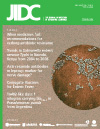Topical treatment of Klebsiella pneumoniae B5055 induced burn wound infection in mice using natural products
DOI:
https://doi.org/10.3855/jidc.312Keywords:
Klebsiella pneumoniae, honey, aloe vera gel, HPMC hydrogelAbstract
Background: Burn wound infection remains the principal cause of death in burn patients. Efficacy of honey and aloe vera gel was evaluated in the treatment of burn wound infection induced with Klebsiella pneumoniae B5055 and their efficacy was compared with an isolated and well-characterized Klebsiella specific phage Kpn5.
Methodology: A full thickness burn wound was induced in mice and infected with K. pneumoniae B5055 via topical route. The efficacy of natural antimicrobial agents (honey and aloe vera gel) topically applied daily was compared with the efficacy of phage Kpn5 suspended in hydrogel applied topically a single time on the burn wound. Efficacy of these antimicrobial agents was assessed on the basis of the percentage of infected mice that survived following treatment.
Results: In comparison to untreated control mice, those treated with a single dose of phage Kpn5 at MOI of 200 showed significant reduction in mortality (P < 0.001). Daily application of honey and aloe vera gel provided significant protection (P < 0.001), but in combination with phage, no additional advantage was observed (P > 0.05) compared to the use of honey and aloe vera gel alone.
Conclusions: The results of this study strongly suggest that phage Kpn5 has therapeutic value in treating burn wound infection in mice as a single topical application of this phage was able to rescue mice from infection caused by K. pneumoniae B5055 in comparison to multiple applications of honey and aloe vera gel.
Downloads
Published
How to Cite
Issue
Section
License
Authors who publish with this journal agree to the following terms:
- Authors retain copyright and grant the journal right of first publication with the work simultaneously licensed under a Creative Commons Attribution License that allows others to share the work with an acknowledgement of the work's authorship and initial publication in this journal.
- Authors are able to enter into separate, additional contractual arrangements for the non-exclusive distribution of the journal's published version of the work (e.g., post it to an institutional repository or publish it in a book), with an acknowledgement of its initial publication in this journal.
- Authors are permitted and encouraged to post their work online (e.g., in institutional repositories or on their website) prior to and during the submission process, as it can lead to productive exchanges, as well as earlier and greater citation of published work (See The Effect of Open Access).








